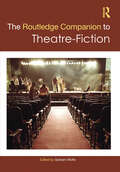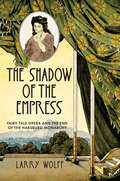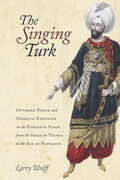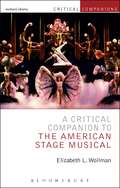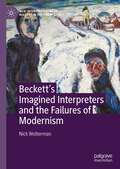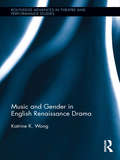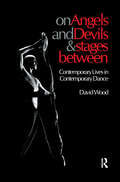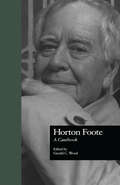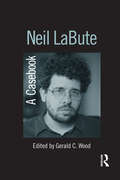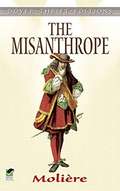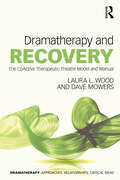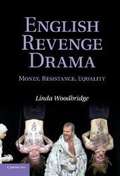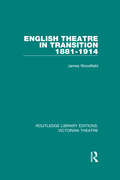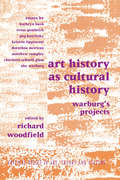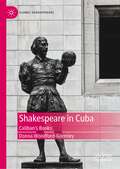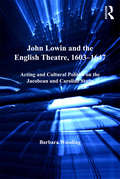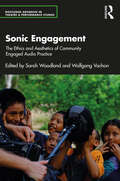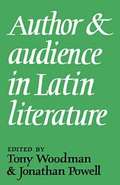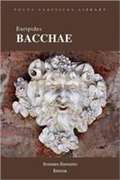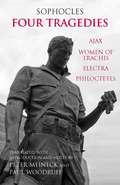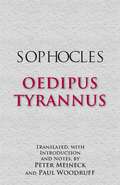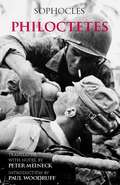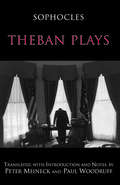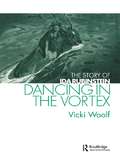- Table View
- List View
The Routledge Companion to Theatre-Fiction (Routledge Literature Handbooks)
by Graham WolfeNovelists have long been attracted to theatre. Some have pursued success on the stage, but many have sought to combine these worlds, entering theatre through their fiction, setting stages on their novels’ pages, and casting actors, directors, and playwrights as their protagonists. The Routledge Companion to Theatre-Fiction has convened an international community of scholars to explore the remarkable array of novelists from many eras and parts of the world who have created fiction from the stuff of theatre, asking what happens to theatre on the pages of novels, and what happens to novels when they collaborate with theatre. From J. W. Goethe to Louisa May Alcott, Mikhail Bulgakov, Virginia Woolf, and Margaret Atwood, some of history’s most influential novelists have written theatre-fiction, and this Companion discusses many of these figures from new angles. But it also spotlights writers who have received less critical attention, such as Dorothy Leighton, Agustín de Rojas Villandrando, Ronald Firbank, Syed Mustafa Siraj, Li Yu, and Vicente Blasco Ibañez, bringing their work into conversation with a vital field. A valuable resource for students, scholars, and admirers of both theatre and novels, The Routledge Companion to Theatre-Fiction offers a wealth of new perspectives on topics of increasing critical concern, including intermediality, theatricality, antitheatricality, mimesis, diegesis, and performativity.
The Shadow of the Empress: Fairy-Tale Opera and the End of the Habsburg Monarchy
by Larry WolffA beguiling exploration of the last Habsburg monarchs' grip on Europe's historical and cultural imagination. In 1919 the last Habsburg rulers, Emperor Karl and Empress Zita, left Austria, going into exile. That same year, the fairy-tale opera Die Frau ohne Schatten (The Woman Without a Shadow), featuring a mythological emperor and empress, premiered at the Vienna Opera. Viennese poet Hugo von Hofmannsthal and German composer Richard Strauss created Die Frau ohne Schatten through the bitter years of World War I, imagining it would triumphantly appear after the victory of the German and Habsburg empires. Instead, the premiere came in the aftermath of catastrophic defeat. The Shadow of the Empress: Fairy-Tale Opera and the End of the Habsburg Monarchy explores how the changing circumstances of politics and society transformed their opera and its cultural meanings before, during, and after the First World War. Strauss and Hofmannsthal turned emperors and empresses into fantastic fairy-tale characters; meanwhile, following the collapse of the Habsburg monarchy after the war, their real-life counterparts, removed from political life in Europe, began to be regarded as anachronistic, semi-mythological figures. Reflecting on the seismic cultural shifts that rocked post-imperial Europe, Larry Wolff follows the story of Karl and Zita after the loss of their thrones. Karl died in 1922, but Zita lived through the rise of Nazism, World War II, and the Cold War. By her death in 1989, she had herself become a fairy-tale figure, a totem of imperial nostalgia. Wolff weaves together the story of the opera's composition and performance; the end of the Habsburg monarchy; and his own family's life in and exile from Central Europe, providing a rich new understanding of Europe's cataclysmic twentieth century, and our contemporary relationship to it.
The Singing Turk: Ottoman Power and Operatic Emotions on the European Stage from the Siege of Vienna to the Age of Napoleon
by Larry WolffWhile European powers were at war with the Ottoman Empire for much of the eighteenth century, European opera houses were staging operas featuring singing sultans and pashas surrounded by their musical courts and harems. Mozart wrote The Abduction from the Seraglio. Rossini created a series of works, including The Italian Girl in Algiers. And these are only the best known of a vast repertory. This book explores how these representations of the Muslim Ottoman Empire, the great nemesis of Christian Europe, became so popular in the opera house and what they illustrate about European-Ottoman international relations. After Christian armies defeated the Ottomans at Vienna in 1683, the Turks no longer seemed as threatening. Europeans increasingly understood that Turkish issues were also European issues, and the political absolutism of the sultan in Istanbul was relevant for thinking about politics in Europe, from the reign of Louis XIV to the age of Napoleon. While Christian European composers and publics recognized that Muslim Turks were, to some degree, different from themselves, this difference was sometimes seen as a matter of exotic costume and setting. The singing Turks of the stage expressed strong political perspectives and human emotions that European audiences could recognize as their own.
A Critical Companion To The American Stage Musical (Critical Companions Series)
by Elizabeth L. Wollman Kevin G. Wetmore Patrick LonerganThis Critical Companion to the American Stage Musical provides the perfect introductory text for students of theatre, music and cultural studies. It traces the history and development of the industry and art form in America with a particular focus on its artistic and commercial development in New York City from the early 20th century to the present. Emphasis is placed on commercial, artistic and cultural events that influenced the Broadway musical for an ever-renewing, increasingly broad and diverse audience: the Gilded Age, the Great Depression, the World War II era, the British invasion in the 1980s and the media age at the turn of the twenty-first century. <P><P> Supplementary essays by leading scholars provide detailed focus on the American musical's production and preservation, as well as its influence on daily life on the local, national, and international levels. For students, these essays provide models of varying approaches and interpretation, equipping them with the skills and understanding to develop their own analysis of key productions.
Beckett’s Imagined Interpreters and the Failures of Modernism (New Interpretations of Beckett in the Twenty-First Century)
by Nick WoltermanSamuel Beckett’s work is littered with ironic self-reflexive comments on presumed audience expectations that it should ultimately make explicable sense. An ample store of letters and anecdotes suggests Beckett’s own preoccupation with and resistance to similar interpretive mindsets. Yet until now such concerns have remained the stuff of scholarly footnotes and asides. Beckett’s Imagined Interpreters and the Failures of Modernism addresses these issues head-on and investigates how Beckett’s ideas about who he writes for affect what he writes. What it finds speaks to current understandings not only of Beckett’s techniques and ambitions, but also of modernism’s experiments as fundamentally compromised challenges to enshrined ways of understanding and organizing the social world. Beckett’s uniquely anxious audience-targeting brings out similarly self-doubting strategies in the work of other experimental twentieth-century writers and artists in whom he is interested: his corpus proves emblematic of a modernism that understands its inability to achieve transformative social effects all at once, but that nevertheless judiciously complicates too-neat distinctions drawn within ongoing culture wars. For its re-evaluations of four key points of orientation for understanding Beckett’s artistic ambitions—his arch critical pronouncements, his postwar conflations of value and valuelessness, his often-ambiguous self-commentary, and his sardonic metatheatrical play—as well as for its running dialogue with wider debates around modernism as a social phenomenon, this book is of interest to students and researchers interested in Beckett, modernism, and the relations between modern and contemporary artistic and social developments.
Music and Gender in English Renaissance Drama (Routledge Advances in Theatre & Performance Studies)
by Katrine K. WongThis book offers a survey of how female and male characters in English Renaissance theatre participated and interacted in musical activities, both inside and outside the contemporary societal decorum. Wong’s analysis broadens our understanding of the general theatrical representation of music, or musical dramaturgy, and complicates the current discussion of musical portrayal and construction of gender during this period. Wong discusses dramaturgical meanings of music and its association with gender, love, and erotomania in Renaissance plays. The negotiation between the dichotomous qualities of the heavenly and the demonic finds extensive application in recent studies of music in early modern English plays. However, while ideological dualities identified in music in traditional Renaissance thinking may seem unequivocal, various musical representations of characters and situations in early modern drama would prove otherwise. Wong, building upon the conventional model of binarism, explores how playwrights created their musical characters and scenarios according to the received cultural use and perception of music, and, at the same time, experimented with the multivalent meanings and significance embodied in theatrical music.
On Angels and Devils and Stages Between: Contemporary Lives in Contemporary Dance (Choreography and Dance Studies Series #Vol. 19)
by David WoodFirst published in 1999. Routledge is an imprint of Taylor & Francis, an informa company.
Horton Foote: A Casebook (Casebooks on Modern Dramatists #24)
by Gerald C. WoodFirst Published in 1998. Routledge is an imprint of Taylor & Francis, an informa company.
Neil LaBute: A Casebook (Casebooks on Modern Dramatists)
by Gerald C. WoodNeil LaBute: A Casebook is the first book to examine one of the most successful and controversial contemporary American playwrights and filmmakers. While he is most famous, and in some cases infamous, for his early films In the Company of Men and Your Friends and Neighbors, Labute is equally accomplished as a playwright. His work extends from the critique of false religiosity in Bash to examinations of opportunism, irresponsible art, failed parenting, and racism in later plays like Mercy Seat, The Shape of Things, The Distance From Here, Fat Pig, Autobahn, and the very recent This Is How It Goes and Some Girls. Like David Mamet, an acknowledged influence on him, and Conor McPhereson, with whom he shares some stylistic and thematic concerns, LaBute tends to polarize audiences. The angry voices, violent situations, and irresponsible behavior in his works, especially those focusing on male characters, have alienated some viewers. But the writer's religious affiliation and refusal to condone the actions of his characters suggest he is neither exploitive nor pornographic. This casebook explores the primary issues of the writer's style, themes, and dramatic achievements. Contributors describe, for example, the influences (both classical and contemporary) on his work, his distinctive vision in theater and film, the role of religious belief in his work, and his satire. In addition to the critical introduction by Wood and the original essays by leading dramatic and literary scholars, the volume also includes a bibliography and a chronology of the playwright's life and works.
The Misanthrope And Other Plays: A New Selection
by John Wood Molière David CowardMolière understood profoundly what makes us noble, pathetic, outrageous and funny, and in his splendid comedies satirized human folly to perfection. One of the best of his plays — and one of the greatest of all comedies — is The Misanthrope, first performed in 1666, when the King of France himself had assumed patronage of Molière's company, and the actor/playwright was at the height of his career. <p><p> Spotlighting the absurdities of social and literary pretension, The Misanthrope shows us a man who is quick to criticize the hypocrisies, inconsistencies and faults of others, yet remains blind to his own. As "the misanthrope" grows more and more irritable with others, the play becomes more and more entertaining, even as a happy ending for the hero seems less and less likely.
Dramatherapy and Recovery: The CoActive Therapeutic Theatre Model and Manual (ISSN)
by Laura L. Wood Dave MowersDramatherapy and Recovery offers a comprehensive and groundbreaking approach to harnessing the power of theater in the recovery process through the use of playmaking and performance.This manual is based on the CoActive Therapeutic Theater (CoATT) model, the first of its kind to be meticulously documented and standardized. With its emphasis on replicability and measurable outcomes, the CoATT model is brought to life through annotated scripts and progress notes extracted from past productions involving diverse populations, including those with eating disorders, aphasia, schizophrenia, and substance abuse disorder. The authors illuminate the six principles that distinguish CoATT from other therapeutic and applied theater approaches. The chapters provide a structured framework compromising seven defined movements that act as attainable milestones for participants guided towards producing a powerful and transformative public performance.Dramatherapy and Recovery equips practitioners of dramatherapy, counseling arts in health, applied theater, community theater, and other mental health disciplines with the tools needed to create transformative performances with individuals reconnecting with the community after treatment.
Hitchcock's Films Revisited
by Robin WoodWhen Hitchcock's Films was first published, it quickly became known as a new kind of book on film and as a necessary text in the growing body of Hitchcock criticism. <p><p>This revised edition of Hitchcock's Films Revisited includes a substantial new preface in which Wood reveals his personal history as a critic -- including his coming out as a gay man, his views on his previous critical work, and how his writings, his love of film, and his personal life and have remained deeply intertwined through the years. This revised edition also includes a new chapter on Marnie.
English Revenge Drama: Money, Resistance, Equality
by Linda WoodbridgeVengeance permeates English Renaissance drama - for example, it crops up in all but two of Shakespeare's plays. This book explores why a supposedly forgiving Christian culture should have relished such bloodthirsty, vengeful plays. A clue lies in the plays' passion for fairness, a preoccupation suggesting widespread resentment of systemic unfairness - legal, economic, political, and social. Revengers' precise equivalents - the father of two beheaded sons obliges his enemy to eat her two sons' heads - are vigilante versions of Elizabethan law, where penalties suit the crimes: thieves' hands were cut off, scolds' tongues bridled. The revengers' language of 'paying' hints at the operation of revenge in the service of economic redress. Revenge makes contact with resistance theory, justifying overthrow of tyrants, and some revengers challenge the fundamental inequity of social class. Woodbridge demonstrates how, for all their sensationalism, their macabre comedy and outlandish gore, Renaissance revenge plays do some serious cultural work.
English Theatre in Transition 1881-1914 (Routledge Library Editions: Victorian Theatre #6)
by James WoodfieldOriginally published in 1984. The turn of the nineteenth and twentieth centuries was a time of considerable change in the English theatre. Victorian attitudes were shocked or shattered by the new drama of Ibsen; the major figure of George Bernard Shaw dominated the period; theatre censorship was the subject of a long and furious contest; and staging conventions changed from the spectacular stylings of Irving and Beerbohm Tree to the masking and statuesque styles of Isadora Duncan and the inner realism of Stanislavsky. This book traces the activities of the leading figures in the English theatre, notably William Archer who introduced Ibsen to this country and who became one of the main promoters of the idea of a National Theatre. Other personalities discussed include Harley Granville Barker, particularly his association with Shaw at the Court Theatre and his part in campaigns against censorship and for changes in the staging of Shakespeare, and Edward Gordon Craig, whose rebellion against the Victorian theatre took and anti-realist direction. This is a stimulating account of the background to the modern English theatre which can only increase appreciation of its standard and variety.
Art History as Cultural History: Warburg's Projects (Critical Voices in Art, Theory and Culture)
by Richard WoodfieldThis book focuses on Aby Warburg (1866-1929), one of the legendary figures of twentieth century cultural history. His collection, which is now housed in the Warburg Institute of the University of London bears witness to his idiosyncratic approach to a psychology of symbolism, and explores the Nachleben of classical antiquity in its manifold cultural legacy. This collection of essays offers the first translation of one of Warburg's key essays, the Gombrich lecture, described by Carlo Ginzburg as 'the richest and most penetrating interpretation of Warburg' and original essays on Warburg's astrology, his Mnemosyne project and his favourite topic of festivals. Richard Woodfield is Research Professor in the Faculty of Art and Design at the Nottingham Trent University, England. He has edited E.H Gombrich's Reflections on the History of Art (1987), Gombrich on Art and Psychology (1996), The Essential Gombrich (1996), and a volume on Riegl in the Critical Voices in Art, Theory and Culture series. He is also the General Editor of a new series of books for G+B Arts International, Aesthetics and the Arts. Edited by Richard Woodfield, Research Professor in the Faculty of Art and Design at Nottingham Trent University, UK.
Shakespeare in Cuba: Caliban’s Books (Global Shakespeares)
by Donna Woodford-GormleyShakespeare in Cuba: Caliban’s Books explores how Shakespeare is consumed and appropriated in Cuba. It contributes to the underrepresented field of Latin American Shakespeares by applying the lens of cultural anthropophagy, a theory with Latin American roots, to explore how Cuban artists ingest and transform Shakespeare’s plays. By consuming these works and incorporating them into Cuban culture and literature, Cuban writers make the plays their own while also nourishing the source texts and giving Shakespeare a new afterlife.
John Lowin and the English Theatre, 1603–1647: Acting and Cultural Politics on the Jacobean and Caroline Stage (Studies in Performance and Early Modern Drama)
by Barbara WoodingEven for scholars who have devoted their careers to the early modern theatre, the name John Lowin may not instantly evoke recognition-until now, the actor's life and contribution to the theatre of the period has never been the subject of a full-length publication. In this study, Barbara Wooding provides a comprehensive overview of the life and times of Lowin, a leader of the King's Men's Company and one of the greatest actors of the seventeenth century. She examines his involvement in the Jacobean/Caroline world as performer, citizen and company manager, and contextualizes his life and career within the socio-economic and political framework of the period. Although references to him in the archives are patchy and sporadic, information about his activities within the King's Men's Company is well documented. In the course of analysing less familiar plays of the period and the characters Lowin played in them, Wooding supplements critical understanding of the scope and range of Caroline drama. Because Lowin's career burgeoned after Shakespeare's and Burbage's death, his life in Southwark and his career with the same company furnishes the opportunity for an examination of the changing status of actors, and the exercising of their skills within the drama of the later playhouse period.
Sonic Engagement: The Ethics and Aesthetics of Community Engaged Audio Practice (Routledge Advances in Theatre & Performance Studies)
by Sarah Woodland Wolfgang VachonSonic Engagement examines the relationship between community engaged participatory arts and the cultural turn towards audio, sound, and listening that has been referred to as the 'sonic turn'. This edited collection investigates the use of sound and audio production in community engaged participatory arts practice and research. The popularity of podcast and audio drama, combined with the accessibility and portability of affordable field recording and home studio equipment, makes audio a compelling mode of participatory creative practice. This book maps existing projects occurring globally through a series of case study chapters that exemplify community engaged creative audio practice. The studies focus on audio and sound-based arts practices that are undertaken by artists and arts-led researchers in collaboration with (and from within) communities and groups. These practices include—applied audio drama, community engaged podcasting, sound and verbatim theatre, participatory sound art, community-led acoustic ecology, sound and media walks, digital storytelling, oral history and reminiscence, and radio drama in health and community development. The contributors interrogate the practical, political, and aesthetic potentialities of using sound and audio in community engaged arts practice, as well as its tensions and possibilities as an arts-led participatory research methodology. This book provides the first extensive analysis of what sound and audio brings to participatory, interdisciplinary, arts-led approaches, representing a vital resource for community arts, performance practice, and research in the digital age.
Author and Audience in Latin Literature
by Tony Woodman Jonathan PowellThe relationship between the author and his audience has received much critical attention from scholars in non-classical disciplines yet the nature of much ancient literature and of its 'publication' meant that audiences in ancient times were more immediate to their authors than in the modern world. This book contains essays by distinguished scholars on the various means by which Latin authors communicated effectively with their audiences. The authors and works covered are Cicero, Catullus, Lucretius, Propertius, Horace's Odes, Virgil's Aeneid, Ovid's Metamorphoses, Senecan tragedy, Persius, Pliny's letters, Tacitus' Annals and medieval love lyric. Contributors have provided detailed analyses of particular passages in order to throw light on the many different ways in which authors catered for their audiences by fulfilling, manipulating and thwarting their expectations; and in an epilogue the editors have drawn together the issues raised by these contributions and have attempted to place them in an appropriate critical context.
Europides' Bacchae
by Paul Woodruff Stephen EspositoAn English translation of Euripides' tragedy based on the mythological story of King Pentheus of Thebes and his fateful encounter with the god DIonysus. Includes an introductory essay, extensive notes, appendices on lacuna, a geneological chart of the gods, and an essay by Valerie M. Warrior: "The Roman Bid to Control Bacchic Worship". The Focus Classical Library provides close translations with notes and essays to provide access to understanding Greek culture and the roots of contemprary thought.
Four Tragedies: Ajax, Women of Trachis, Electra, Philoctetes
by Paul Woodruff Peter Meineck SophoclesMeineck and Woodruff's new annotated translations of Sophocles' Ajax, Women of Trachis, Electra, and Philoctetes combine the same standards of accuracy, concision, clarity, and powerful speech that have so often made their Theban Plays a source of epiphany in the classroom and of understanding in the theatre. Woodruff's Introduction offers a brisk and stimulating discussion of central themes in Sophoclean drama, the life of the playwright, staging issues, and each of the four featured plays.
Oedipus Tyrannus
by Paul Woodruff Peter Meineck SophoclesPeter Meineck and Paul Woodruff's collaboration on this new translation combines the strengths that have recently distinguished both as translators of Greek tragedy: expert knowledge of the Greek and of the needs of the teaching classicist, intimate knowledge of theatre, and an excellent ear for the spoken word. Their Oedipus Tyrannus features foot-of-the-page notes, an Introduction, stage directions and a translation characterized by its clarity, accuracy, and power.
Philoctetes
by Paul Woodruff Peter Meineck SophoclesFirst published in Peter Meineck and Paul Woodruff's Sophocles: Four Tragedies, this riveting translation by Peter Meineck of Sophocles' Philoctetes features a new Introduction by Paul Woodruff.
Theban Plays
by Paul Woodruff Peter Meineck SophoclesThis volume offers the fruits of Peter Meineck and Paul Woodruff's dynamic collaboration on the plays of Sophocles' Theban cycle, presenting the translators' Oedipus Tyrannus (2000) along with Woodruff's Antigone (2001) and a muscular new Oedipus at Colonus by Meineck. Grippingly readable, all three translations combine fidelity to the Greek with concision, clarity, and powerful, hard-edged speech. Each play features foot-of-the-page notes, stage directions, and line numbers to the Greek. Woodruff's Introduction discusses the playwright, Athenian theatre and performance, the composition of the plays, and the plots and characters of each; it also offers thoughtful reflections on major critical interpretations of these plays.
Dancing in the Vortex: The Story of Ida Rubinstein (Choreography and Dance Studies Series #Vol. 20.)
by Vicki WoolfParis at the turn of the century - Art Nouveau, Renoir, Toulouse-Lautrec and the Folies Bergere. This was the atmosphere which nurtured the artistic development of the remarkable dancer and choreographer Ida Rubinstein.This long-awaited biography gives us a unique insight into the life of a remarkable woman, responsible for a fascinating chapter of our artistic heritage. She was a chameleon, a diva, who lived many lives, overcoming the anti-Semitism of her times to enchant and captivate the highest of societies.Untrained as a dancer, Ida Rubinstein's charisma attracted collaborators such as Debussy, Stravinsky, Ravel, Cocteau, Bakst, and Benois.
